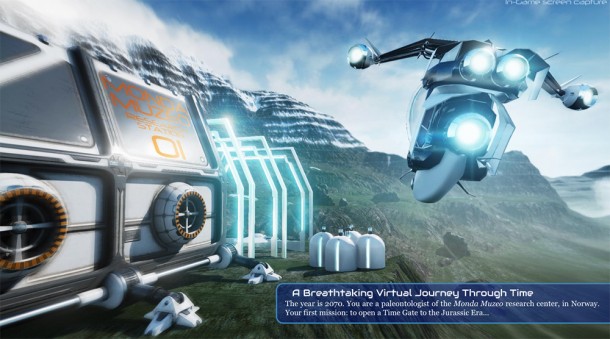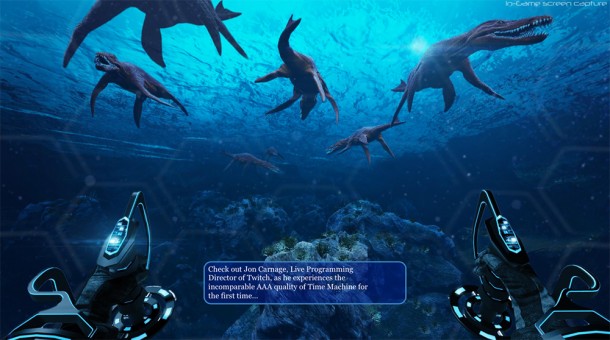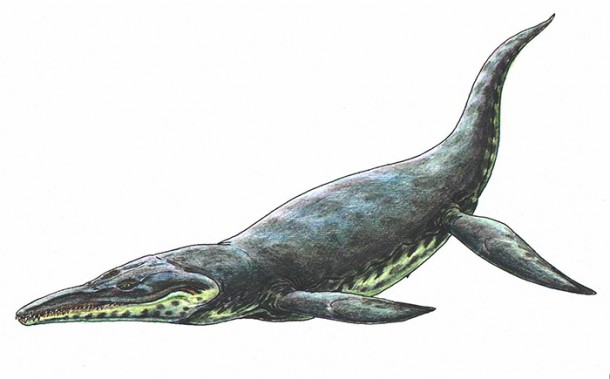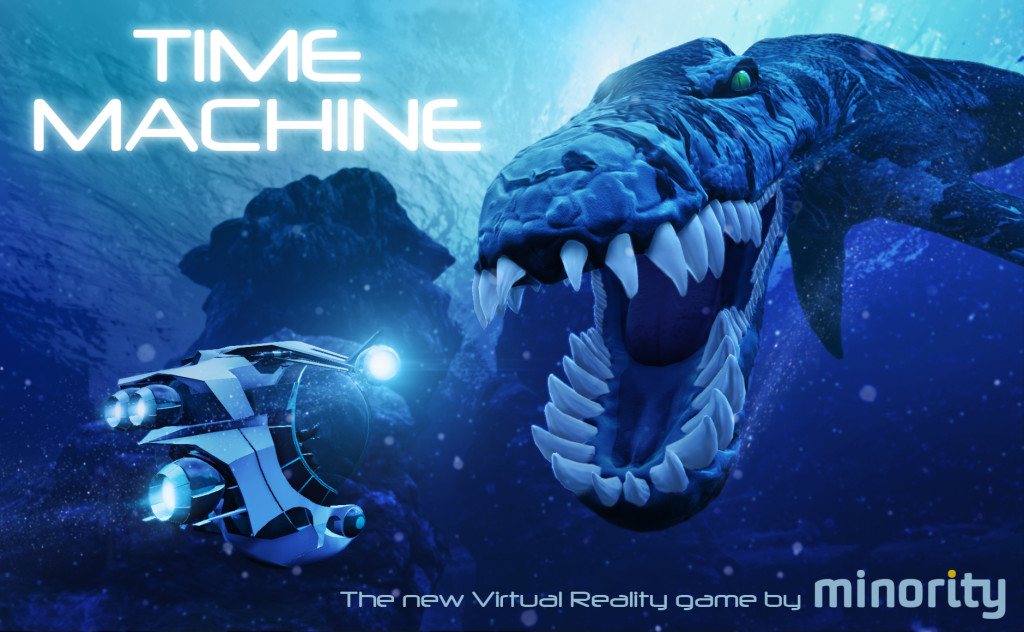
Minority are well known for games that capture emotion, reflecting them back to us in novel ways that only the medium can provide. Papo y Yo, for instance, was a brave look at childhood abuse. Spirits of Spring tackles bullying by incorporating ethereal Northern mythology. Both times the company used the respective platforms to their strengths to deliver a unique interactive experience.
But this is the year of VR. This is the year that creating content in three immersive dimensions can lead to incredible new possibilities. Minority looks to continue their innovation with the technology du jour, but only by making sure that there is a strong enough narrative behind it.
And they’re doing it with dinosaurs.
Time Machine VR may or may not be the final name for the project that the company is currently working on, but it’s possibly the most descriptive. The game, set in the year 2070, tasks us to travel back in time to scan prehistoric beats for information. Scratch that; it tasks us to scan them for confirmation. There’s a difference. You see, with all violence and war eradicated from the world our funds have turned to progressing science. Time travel seems to have bubbled up as the leading endeavor, and with it we aim to discover our past. We play as a sort of “tie-breaker”, sent back in time for deduce which of the many battling theories of dinosaur physiology are correct.
That’s all fine and dandy, but it raises moral and ethical questions about exploring the past just for our own enjoyment. It has the ability to confirm one side of beliefs but shatter others. Think about it in these relative terms: if we could go back to see Jesus Christ born (or not born), that could completely rip apart the religious world based on what we see. It would take whatever level of peace we have right now and crush it, spinning society out of control. That’s the level of thought that Minority is planning with TMVR: just because we could see the past, does it mean we should?

That aspect of the narrative is being flushed out now by the 15-person team, several of which are writers with experience in games like the Assassin’s Creed franchise. There will be intrigue, conflicts, and choices that we will have to make as players that will weigh heavy on our progress.
But the game has only been in development for around 4 months, and so there is plenty of work to be done in that respect. The demo on the PAX East show floor featured what amounts to assort of technical proof of concept.
I strap on the Oculus. The demo begins with a quick tutorial of the controls; look one way, look the other. Look up, look down at my legs, hold the trigger to lock on and scan. These are FPS controls, albeit used in a non-violent way. Besides scanning and mobility, I’m also given a “Time Stop” ability that slows (or stops) time down to a crawl for a few seconds. More abilities and tools are being discussed and developed that will aid in puzzle-solving. In fact the game will be devoid of forced attacks completely, as the company is aiming for a specific childhood sense of experience in which discovery and surprise are tantamount.
That’s also why going to VR is so important. Up until now, exploration adventure games have mostly been presented on a flat screen. Virtual reality works great with the premise, in which knowledge of the environment around us is as important to the experience as what we see right in front of us. The technology lets us get surrounded by the story instead of just witnessing it played out.

As I move around the scientific station, I notice the serene mountain scene around it. Peace of the future is reflected in the peacefulness of the Earth, it seems. My pod hovers and floats, sliding a little to the left and right depending on my inertia. Off in the distance I see a glowing marker that points me to the time portal. I make my way there, enter the portal, and am instantly zapped into the past.
I’m underwater, in what appears to be a lake. As I look down I see the dark muck, and as I look up I see the sunlight reflecting on the surface. The view is actually enhanced by the water, providing a visual depth that mimics deep water. At first I don’t know where to go, but I’m soon notified that my scannable target is nearby. As bubble around a ridge I see them: an underwater heard of pliosaurs. For the record: Pliosaurs aren’t dinosaurs — they’re actually reptiles. But, for demo purposes this is a better way to show off the idea in the short amount of time. I creep up to them quietly, planning my slow pod’s movement to make sure I can catch one off guard. They swim around me, almost playfully, as schools of fish float by. Am I going to be eaten? I don’t think so… I appear to be too big for them to pose a threat. However they move fairly quickly, and the only way I can scan them is to use my Time Stop. Scanning takes a few seconds but it works, and I’m awarded what amounts to as a thumbs up before I head to my next target.
“Are you ready for something a little different,” Rommel Romero, one of the creators of the game, says to me over the show floor noise.
“Sure, let’s try it.”
The scene shifts to a different part of the lake (or perhaps a different lake all together?) and I’m once again in an open field in the water. The path in front of me winds around, dipping past rocks and flora. And then I see them: huge beasts, circling a protruding rock enclosure. They already look larger than the ones I’ve just scanned. And then a shadow. As I turn my pod I see it, swimming over the rest of the other beasts. It’s gigantic. A kronosaurus? I don’t know. I grip the game controller tightly. This thing is massive, I think to myself.

“Go ahead, try to scan it.”
Okay, let’s give this a shot. I turn towards the monster, thinking that I can sneak up on it from the side to scan. NOPE. It notices me almost instantly, turning its massive head and opening its jaws. They fill almost my entire peripheral vision. I’m squeezing the controller, sure that I’m be breaking it. Too late; I’ve been eaten. I try again, making my way across the field to the rocks, but this time I hide in an alcove as the beast makes its way around.
“Don’t forget the Time Stop.”
The Time Stop! As the pliosaur turns the corner, it sees me again and opens it jaws. I stop time, catching it a fairly terrifying pose. I instantly begin scanning, unknowing how long my Time Stop can last. The scan completes, and I’m given a good pat on the back.
Intense. That’s probably the best way to describe the demo. While we may never see this scene actually play out in the game itself, it still felt authentic and reflected the intent of the idea. As a proof of concept it worked well, as a demo of the possibilities of VR it worked extremely well. These kinds of ideas are, in my opinion, what make VR so interesting. I don’t need to shoot dinosaurs, I just need to see them.
Time Machine VR still has a very long way to go. There may be more eras of exploration and more dinosaurs, and final platforms (Oculus, Morpheus, Vive) are yet to be determined, but Minority is aiming to have the game release close to the public launch of VR. They want to be the kind of experience that sells the technology to a broader audience. If the final game develops with the same intensity that I felt in the demo, then they may not be far off.


No Comments